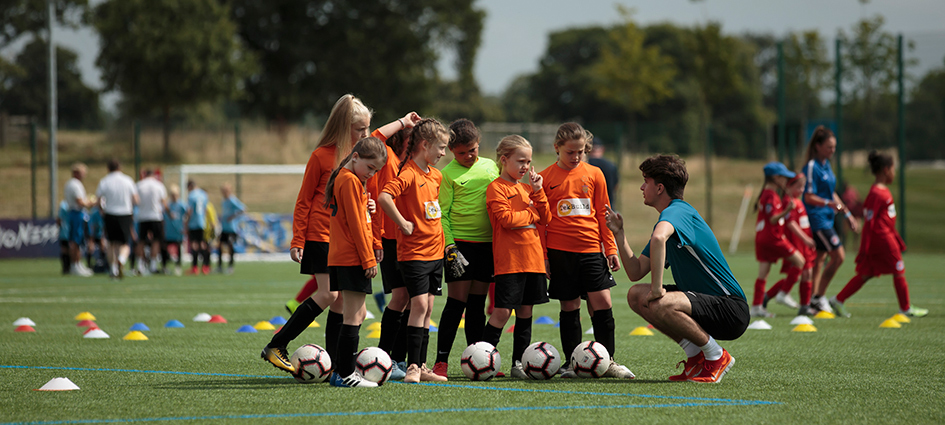Effective practice design

Maximising your training time with players
- Daniel Fenner and Steve Lilley
- 27 November 2019
FA county coach developers, Daniel Fenner and Steve Lilley, explore the benefits of sharing session plans with your team ahead of the session.
What strategies do you have in place to maximise the limited time you have with your players on a training night?When coaching in the grassroots environment, time is often limited, and in our experience, players like to have maximum time on the pitch to practise with the ball - hopefully achieving England DNA Fundamentals 70% ball rolling time.
One way to maximise our time with the players, is to ‘flip the script’, which can enhance decision-making and game sense through an inverted approach to coaching. It’s a popular approach adopted in academia (known as flipping the classroom) and has proved effective in terms of long-term learning.
An example of this is providing your players with a session plan a day or two before training, so they can see - and try to make sense of - the learning outcomes, their role within the session, and what the practices might look like, before they arrive.
“Sending out session plans in advance can help your coaching in several different ways, especially if you only have an hour or two with your group every week,” explains Andy Edwards, an under 14’s coach working in Gloucestershire.
“Players can watch and read relevant videos or articles and be prepared for what to expect during the session - this can save time and help players’ understanding of why we are doing particular activities.”

For instance, you might send a Foundation Phase video from The Boot Room via WhatsApp to your U10’s parents who could explain the clip to their child. This would equip the player with a visual insight into what they’ll be doing. It doesn’t have to take the place of tactics boards, iPads, explanations or demonstrations of the practice.
However, what it will do is allow the players who have seen the video, a chance to ask more in-depth questions and increase time on the field to practise. It also encourages those ‘forgers’ the opportunity to research and improve further, thus managing difference as a coach.
Louis Dean, an under 13’s coach in Gloucestershire, believes this is a good tactic to adopt, particularly as young players in today’s society could value a digital-led approach.
“Young players learn in a number of different ways. Showing them videos of what we would like them to try and complete is often better than us explaining. The youth of today are so digital and I feel all coaches need to get to understand each player individually. Some players understand formations based on playing FIFA, some like watching videos and others prefer to read.
“Giving the players as much information [about the session] in a short period of time makes it easier for them. So, a simple 9 second clip, they are happy to watch and they understand straight away what we, as coaches, are trying to achieve.”
Before using this approach, take a look at the table below, which highlights the possibilities that might occur when you ‘flip the script’.
| Before the flip | After the flip | |
|
Before practice |
Players don’t always know what they’re going to do in practice. They just show up.
|
Players are guided through key concepts (possibly online) then can ask questions and collect responses. Coach prepares base knowledge and previews training/game objectives.
|
|
Beginning of practice |
Players have limited knowledge of what to expect. The coach will make general assumptions about what will be helpful based on their observations.
|
Players have specific questions in mind to guide their learning. The coach can anticipate where players will need assistance the most.
|
|
During practice |
Players try to follow along whilst the coach uses various toolkit coaching interventions to cover the key concepts.
|
Players apply the skills or key concepts they’re expected to learn from pre-practice information. The coach guides the process with feedback and guided questions.
|
|
After Practice |
Players may attempt some work outside of practice but not always connected to the learning objectives set by the coach.
|
Players continue to apply their knowledge and skills after receiving clarification and feedback. The coach provides additional explanations and resources as necessary.
|
Advantages
- It will help create independent learners.
- It’s engaging.
- Players learn at different rates.
- You can find out what your players think and what they know.
- Content becomes available beyond typical practice time - they can stop, pause and play whenever they want, and they can think about questions before coming to training.
- Technology isn’t a big barrier anymore, it’s how children communicate and learn.
Disadvantages
- It takes time to prepare.
- You need to acquire the right content/video/technology.
- You need to make the content accessible.
- You have to work hard to create a safe environment where it’s ok to fail and for players to ask questions.
The above article is based on a presentation at the 2019 United Soccer Coaches convention.























